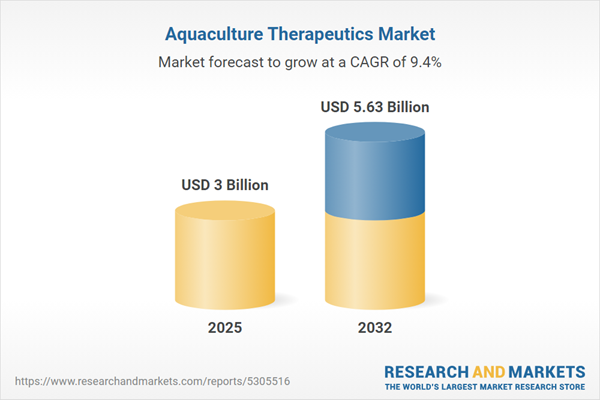Speak directly to the analyst to clarify any post sales queries you may have.
The global aquaculture therapeutics market is witnessing rapid transformation as industry stakeholders prioritize advanced health solutions to sustain marine livestock productivity, ensure regulatory compliance, and meet shifting consumer demands.
Market Snapshot: Aquaculture Therapeutics Market Growth and Trends
The Aquaculture Therapeutics Market grew from USD 2.74 billion in 2024 to USD 3 billion in 2025. It is expected to continue growing at a CAGR of 9.40%, reaching USD 5.63 billion by 2032.
Scope & Segmentation: In-Depth Coverage of Therapeutic Types, Species, and Geographies
- Therapeutic Types: Antibiotic options such as broad and narrow spectrum, disinfectants including chlorine and quaternary ammonium compounds, immunostimulants from beta glucan and herbal extracts, probiotic products based on bacterial and yeast strains, as well as vaccines ranging from inactivated and live attenuated to recombinant.
- Species Coverage: Crustacean species (prawn, shrimp), fish species (carp, salmon, tilapia), and mollusks (mussel, oyster).
- Application Areas: Includes both curative and preventive approaches.
- Mode of Administration: Immersion, injection, and oral delivery methods.
- Distribution Channels: Direct sales, distributors, and online platforms.
- Regional Analysis: Americas (including key countries such as United States, Canada, Brazil, Chile); Europe, Middle East & Africa (including United Kingdom, Germany, France, Russia, South Africa); Asia-Pacific (China, India, Japan, Australia, Indonesia and others).
- Company Profiles: Features leading and innovative firms such as Zoetis Inc., Elanco Animal Health Incorporated, Ceva Sante Animale SA, Merck & Co., Inc., DSM Nutritional Products AG, Novozymes A/S, and regional specialists like Benchmark Holdings PLC.
Aquaculture Therapeutics Market: Key Takeaways for Decision-Makers
- Adoption of advanced diagnostics and targeted therapeutics is enhancing early disease management and supporting operational efficiency.
- Industry is pivoting from traditional, broad-spectrum antibiotics toward next-generation immunostimulants, probiotics, and innovative vaccine platforms.
- Increasing regulatory scrutiny and monitoring programs are driving demand for compliant, science-backed solutions with transparent supply chains.
- Regional markets exhibit distinct segment priorities: crustacean and mollusk producers focus on rapid-acting, cost-effective treatments, while fish farmers invest more in long-term immunity through oral and injectable products.
- Strategic partnerships between established pharma leaders and technology innovators are reshaping competitive differentiation and accelerating the development of residue-free, sustainable products.
- Digitalization is streamlining administration routes and monitoring, enabling more precise deployment and reduced product waste.
Tariff Impact: Updates on Regulatory and Trade Dynamics
Recent United States tariffs have altered supply chain strategies for aquaculture therapeutics, prompting suppliers to diversify sourcing and expand local manufacturing. Organizations able to anticipate such regulatory shifts are leveraging domestic production, collaborative alliances, and R&D investment to remain competitive and resilient in the face of trade barriers.
Methodology & Data Sources
Research was underpinned by primary interviews with aquaculture veterinarians, regulatory authorities, and senior executives. Peer-reviewed literature, regulatory filings, quantitative analyses of disease incidence and product efficacy, and advisory council reviews all contributed to the accuracy and reliability of insights presented in this report.
Why This Report Matters: Actionable Insights for Aquaculture Health Leaders
- Equip decision-makers with detailed segmentation and regional trends for optimized product portfolios and go-to-market planning.
- Enable proactive risk management by clarifying the impact of regulatory changes and supply chain adjustments.
- Empower organizational strategy with validated, actionable recommendations for advancing digital integration and sustainable procurement.
Conclusion
This report offers a clear path for stakeholders to navigate evolving aquaculture therapeutics, leveraging technological progress and collaborative strategies. Companies aligning innovation and execution will be best positioned to secure sustained value in this transforming landscape.
Additional Product Information:
- Purchase of this report includes 1 year online access with quarterly updates.
- This report can be updated on request. Please contact our Customer Experience team using the Ask a Question widget on our website.
Table of Contents
3. Executive Summary
4. Market Overview
7. Cumulative Impact of Artificial Intelligence 2025
Companies Mentioned
The companies profiled in this Aquaculture Therapeutics market report include:- Zoetis Inc.
- Elanco Animal Health Incorporated
- Ceva Sante Animale SA
- Merck & Co., Inc.
- Phibro Animal Health Corporation
- DSM Nutritional Products AG
- Novozymes A/S
- Chr. Hansen Holding A/S
- Vetoquinol SA
- Benchmark Holdings PLC
Table Information
| Report Attribute | Details |
|---|---|
| No. of Pages | 183 |
| Published | October 2025 |
| Forecast Period | 2025 - 2032 |
| Estimated Market Value ( USD | $ 3 Billion |
| Forecasted Market Value ( USD | $ 5.63 Billion |
| Compound Annual Growth Rate | 9.4% |
| Regions Covered | Global |
| No. of Companies Mentioned | 11 |









